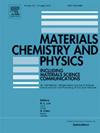二氧化钒薄膜相变动力学的原位 XRD 研究
IF 4.3
3区 材料科学
Q2 MATERIALS SCIENCE, MULTIDISCIPLINARY
引用次数: 0
摘要
二氧化钒(VO2)因其独特的可逆热致变色金属绝缘特性,在能源相关领域有着巨大的应用潜力。本文利用原位 XRD 技术研究了二氧化钒薄膜的相变动力学,它可以从单斜二氧化钒(M)转变为四方金红石型二氧化钒(R)。VO2 薄膜的制备采用简单的溶液溶胶凝胶法,然后在石英基底上进行旋涂,以达到纳米级的厚度。加热过程中,VO2(M)的临界相变发生在 70 °C,冷却过程中降至 45 °C。根据 Koistinen 和 Marburger(KM)技术建立了马氏体类晶相转变动力学模型。利用 Rietveld 方法定量分析了两种相的相对含量,并得出了从 VO2 (M) 加热到 VO2 (R) 和从 VO2 (R) 冷却到 VO2 (M) 的转化率系数 α 分别为 0.20345 和 0.12585。这项研究为了解薄膜 VO2 的结构特征提供了有效的工具,为其未来在智能窗户等能源相关领域的设计和应用铺平了道路。本文章由计算机程序翻译,如有差异,请以英文原文为准。
In-situ XRD study on phase transition kinetics of vanadium dioxide thin film
Vanadium dioxide (VO2) has great potentials to be used in energy-related fields due to its unique reversible thermochromic metal-insulating properties. In this paper, we used in-situ XRD technique to study the phase transition kinetics of VO2 thin films, which can change phase from monoclinic VO2 (M) to tetragonal rutile VO2 (R). The VO2 thin films were prepared by a simple solution-based sol-gel method followed by spin coating to achieve the nanoscale thickness on a quartz substrate. During heating, the critical phase transition of VO2 (M) occurred at 70 °C, which dropped to 45 °C during cooling. A martensite-like crystal phase transformation kinetic model was established based on the Koistinen and Marburger (KM) technique. The relative content of the two phases was quantitatively analyzed using the Rietveld method, and the transformation rate coefficient α was obtained as 0.20345 and 0.12585, for the heating process from VO2 (M) to VO2 (R) and the cooling process from VO2 (R) to VO2 (M), respectively. This research offers an effective tool for understanding the structural characteristics of thin film VO2, paving the way for its future design and applications towards energy-related fields such as in smart windows.
求助全文
通过发布文献求助,成功后即可免费获取论文全文。
去求助
来源期刊

Materials Chemistry and Physics
工程技术-材料科学:综合
CiteScore
8.70
自引率
4.30%
发文量
1515
审稿时长
69 days
期刊介绍:
Materials Chemistry and Physics is devoted to short communications, full-length research papers and feature articles on interrelationships among structure, properties, processing and performance of materials. The Editors welcome manuscripts on thin films, surface and interface science, materials degradation and reliability, metallurgy, semiconductors and optoelectronic materials, fine ceramics, magnetics, superconductors, specialty polymers, nano-materials and composite materials.
 求助内容:
求助内容: 应助结果提醒方式:
应助结果提醒方式:


